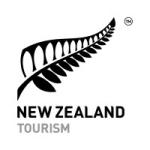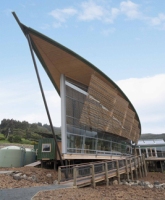Rare NZ parrot to make RWC appearance
Sirocco, the rare New Zealand kākāpō parrot whose frisky behaviour with a BBC television crew propelled him to global stardom, will make some cameo appearances during Rugby World Cup.
A bachelor who usually lives a solitary life on a remote island sanctuary, Sirocco will spend two months on the mainland - in Dunedin and Wellington - offering visitors a once-in-a-lifetime chance to meet one of world's most unique and endangered avian survivors.
Sirocco is one of 131 living kākāpō - a tiny population of large flightless parrots that’s been brought back from the brink of extinction through a world-leading conservation programme.
Sirocco’s mainland holiday will highlight his mission as an advocate for New Zealand's Kākāpō Recovery Programme because, even after 30 years of conservation efforts, his species is not yet out of the woods.
Apart from occasional roving ambassador Sirocco, the birds reside off-shore on predator-free islands where they are closely monitored and supported by conservation workers, but not accessible to the public.
Youtube exploits
Sirocco became an international sensation in 2009 when he appeared on the BBC's 'Last Chance to See' documentary series - caught on camera enthusiastically "shagging" British zoologist Mark Carwardine’s head.
Sharp-clawed Sirocco took an instant shine to Carwardine, climbed on his head and set about mimicking the awkward mating ritual of the world's heaviest parrot species.
The sensational footage - which shows the bemused presenter Stephen Fry telling Carwardine that he's "being shagged by a rare parrot" - turned Sirocco into an internet star with over 3 million views on YouTube.
He is now the world’s first official spokesbird for conservation, has 7,000-plus Facebook fans and over 3,000 Twitter followers.
Mainland sanctuary
New Zealand’s most famous bird will set up temporary residence in Orokonui Ecosanctuary, near the South Island city of Dunedin, and in Wellington at Zealandia - the capital city’s award-winning inner city sanctuary, during September and October.
Kākāpō are nocturnal so both sanctuaries will be offering guided evening eco experiences to meet Sirocco. These will be ticketed events for a limited number of visitors.
Sirocco will be at Orokonui from 3 - 26 September, and at Zealandia in October.
Hosting Sirocco would be a privilege, and help people to understand how remarkable New Zealand's natural history was, Zealandia chief executive Nancy McIntosh-Ward said.
"This is an amazing opportunity for locals and visitors to come face to face with one of the strangest, rarest and most charismatic of New Zealand’s native species."
"Kākāpō evolved to flourish in an environment free of mammalian predators but came very close to extinction after the introduction of mammalian pests."
Kākāpō Recovery partnership
New Zealand's 131 kākāpō are under the care of the world-leading Kākāpō Recovery Programme - a long-standing partnership between the Department of Conservation (DOC), Rio Tinto Alcan and NZ Forest and Bird.
Kākāpō Recovery Programme manager Deidre Vercoe Scott said the team had been looking at new ways to raise awareness of their work to save the iconic parrot.
"Given the small kākāpō population is closely managed on offshore islands, it is really difficult to get a first hand appreciation for these unique birds," Vercoe Scott said.
"Sirocco was hand-reared alone as a chick and now seeks out human contact, so he provides a great opportunity to allow people to engage with these special parrots."
Rugby World Cup 2011
With his international profile, Sirocco would be a good "fit" to welcome 2011 Rugby World Cup visitors to New Zealand, she said.
"I’m not really sure how much he loves rugby but Sirocco certainly likes the limelight. On previous occasions he’s entertained visitors at both Auckland Zoo and on Ulva Island and he coped extremely well."
Sirocco would be housed in specially-built enclosures set in native forest sites, allowing visitors to experience kākāpō in the natural environment.
"We have strict guidelines in place for his health and welfare, and we are confident Sirocco will thrive with the attention."
Background: Orokonui Ecosanctury, Dunedin
The 307ha Orokonui Ecosanctuary - 20km north of Dunedin - is restoring an entire forest ecosystem to its pre-human state to provide a haven away from introduced predators for native birds, lizards, fish and insects.
One of New Zealand’s newest wildlife sanctuary projects, Orokonui is an example of a relatively new conservation tool - predator-proofed fencing around a mainland sanctuary area. The 9km fence was completed in July 2007, and the area was then subjected to a pest eradication programme.
Endangered species being protected behind the fence include: South Island kaka, South Island saddleback, South Island robin, Haast tokoeka kiwi and jewelled geckos.
For details about Sirocco Tours at Orokonui visit: www.orokonui.org.nz
Background: Zealandia, Wellington
An inner city slice of native paradise within New Zealand's capital city, Zealandia is acknowledged as one of Australasia’s top 25 ecological restoration projects.
The multi-million dollar project - the result of a 500-year vision to return part of Wellington to its pre-human state - has involved developing 252 hectares of native forest into a native wildlife haven behind predator-proof fences.
Native flora and fauna have been reintroduced including rare New Zealand tuatara reptiles, and flightless birds such as the weka and kiwi. The unique protected area has over 35km of tracks through regenerating forest.
For details about Sirocco Tours at Zealandia visit: www.visitzealandia.com
Background: Kākāpō - flightless parrot
- Kākāpō are flightless.
- Kākāpō are the world’s heaviest parrot species.
- Kākāpō are possibly the oldest living bird in the world.
- Kākāpō have a subsonic mating boom that can travel several kilometers.
- Nineteenth-century explorer Charles Douglas noted that he could shake a tree and kākāpos would fall like ripe apples.

